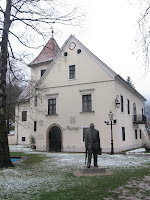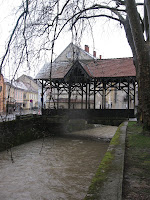Have you ever noticed that my blog has covered many places west of Germany but hardly anywhere east? It is time that I set foot somewhere further east than Vienna and venture into a less familiar world. Having read about this country from a respectable magazine from Hong Kong, and being a place where my Hong Kong friends in Munich and I all haven't been before, we decided on a 4-day whirlwind tour through Croatia.
Our overnight train took us to the capital Zagreb on the morning of Good Friday (21 March). After asking for various information and changing our currency (yes, my blog entries haven't covered too much outside the euro-zone either!) we set out to explore the city. It may not be as exciting and packed with attractions around every corner compared to other capital cities, but at least Zagreb feels pleasant, unhurried and is filled with open space. We started from the main railway station (Glavni Kolodvor) and walked through the streets and squares of the Lower Town district (Donji Grad). Then we met up with a local who was spent a few months last year at my work place, and she took us to a family restaurant for a traditional Croatian Good Friday lunch. She also showed us a couple of other places good for afternoon tea and dinner. All three of us couldn't agree more that she's definitely in the know of how to eat well!
We continued our exploration of the Kaptol district of the city, and the main attraction there was the Cathedral of Assumption (Katedraia Marijina Uznesenja). Some remains of a wall separated the Kaptol from the Upper Town district (Gornji Grad). At the foot of the Upper Town was a rather trendy street called Tkalčićeva where we had afternoon tea. Then we walked uphill, through the Stone Gate (Kamenita Vrata) into the centre of Upper Town where we saw the St. Mark's Church (Crkva sv. Marka) with its colourful roof. That was also where we could get a view of the whole Zagreb from above. From there we made it back to the Lower Town and had a seafood dinner in a restaurant in the market area (Dolac).
We returned to Zagreb on Easter Monday (24 March) having been to Dubrovnik in the south and Split in the central coast over the weekend. Our Croatian host invited us to dinner at her place later in the evening, and she recommended a nearby village called Samobor for a visit during the day. Once we walked outside the town centre, we saw a derelict castle on top of a hill. It would have been an interesting short expedition up to the castle, except we were deterred by the sleet and the slippery muddy path that we haven't equipped ourselves for. We later found out that the hill was in fact only one small part of the countryside surrounding Samobor. Back in Zagreb, we were looking forward to a delicious home-made dinner by our host, and we weren't disappointed. That brought our journey through Croatia to a full and satisfying (!) conclusion.
大家看我的網誌,旅遊地點談來談去都是德國以西的,最東面的也祇是維也納,新鮮不再吧?是時後發掘歐洲東部的新地點了。讀過香港《信報財經月刊》連續幾期的介紹,令我對克羅地亞產生興趣,而且在慕尼黑的香港朋友也想遊遊東歐,我們就選了這個我們三人都未曾踏足的國家,趁復活節作四日旋風式旅程。
我們乘過夜火車,3月21日早抵達克羅地亞首都薩格勒布,詢問旅遊資料及找換當地貨幣後(有沒有發覺我從前的旅程大都離不開歐元區呢?)我們便往市區逛逛。薩格勒布雖不像其他大城市一樣目不暇給,景點處處,但勝在地方開揚,令人覺得優悠自在。我們從火車總站Glavni Kolodvor出發,路經下城區(Donji Grad)的幾個廣場和公園後,便和我的克羅地亞朋友(她去年曾在我的實驗室當過三數月實習)會合,由她帶我們往一家家族經營的餐廳,享用一頓地道復活節最期五午餐,飯後她也帶我們到她推介的下午茶及晚餐地點,她確是個很會吃喝的人,我們後來都一致認同她的介紹果然不錯。
我們三人繼續行程,前往Kaptol區,參觀該區最有名的瑪利亞升天教堂(Katedraia Marijina Uznesenja)。Kaptol區與毗鄰的上城區(Gornji Grad)隔了一段城牆,上城區的山腳,有一條很潮的街道,名為Tkalčićeva,我們在那裡吃過下午茶後再往山上行,穿過石門(Kamenita Vrata),便進入了上城區的中心,看到屋背色彩繽紛的聖馬可教堂(Crkva sv. Marka),也走到一個大平台,俯瞰薩格勒布的景色,我們從那裡走回下城區,並在那裡的市集(Dolac)附近吃晚飯。
22、23兩天在另兩個城市Dubrovnik及Split遊玩後,我們在24日返回薩格勒布,那天晚上我的克羅地亞朋友邀請我們到其府上作客,白天時那個朋友就介紹我們前往薩格勒布附近的Samobor鎮逛逛。走出該鎮的中心,不遠的山上有座破落了的堡壘,本想上去看看,但當時下起雨雪,想必山路一定濕滑,我們也非有備而來,算是與破城堡無緣了。後來我們看過Samobor的地圖,才知該堡壘的山頭,祇是Samobor郊野的一小部分。回到薩格勒布,在朋友家中吃到一頓豐富的晚餐,「腹」滿意足地結束了克羅地亞之旅。
Zagreb 薩格勒布


Glavni Kolodvor and the Tomislavov Square opposite to it
Glavni Kolodvor火車總站及對面的Tomislavov廣場

The Zrinjevac Park, a couple of streets away from Tomislavov Square
離Tomislavov廣場兩個街口的Zrinjevac公園


Left: Meštrović Art Pavilion; right: Croatian Central Bank
左:Meštrović藝術館、右:克羅地亞中央銀行


The Ban Josip Jelačić Square (Trg bana Josipa Jelačića) and the adjacent Jurišićeva Street
Ban Josip Jelačić廣場(Trg bana Josipa Jelačića)及相連的Jurišićeva街

The traditional Good Friday dish - cod fish in mashed potato
復活節星期五午餐——薯蓉炆鱈魚

Dolac
市集



Cathedral of Assumption (Katedraia Marijina Uznesenja)
瑪利亞升天教堂


Tkalčićeva

Taking café culture to the next level of luxury and comfort
露天歎咖啡是可以這樣「歎」的!


The Stone Gate (Kamenita Vrata) 石門

St. Mark's Church (Crkva sv. Marka)
聖馬可教堂


Zagreb from the Upper Town 從上城區看到的薩格勒布


The furnicular linking the Upper Town and Lower Town
連接上、下城區的纜車


Left: Arts and Craft Museum; right: Croatian National Theatre
左:手工藝博物館、右:克羅地亞國家歌劇院


Left: Mimara Museum; right: Croatian National Archives
左:Mimara博物館、右:克羅地亞國家檔案處


Typical Zagreb residences, in my Croatian friend's neighbourhood
克羅地亞朋友居住的區域的尋常百姓家
Samobor


Town centre 鎮中心


Desolation and dereliction, high up and down below
同病相連的堡壘和民房

The church below the deserted castle
堡壘山腳的教堂

Samobor Museum
Samobor博物館


Samobor by the water Samobor的小河

Did I see Venice here?
威尼斯的影子

Parish Church of St. Anastasia (Župna Crkva sv. Anastazije)
聖茜雅教堂

This bench will be ripped apart again when it snows!
拆了長椅,去滑雪可也!

Samobor bustled up with the filming of this TV commercial! See the video below (unfortunately it's not from the right side).
Samobor怎麼會突然熱鬧起來?原來有班人拍廣告。我們錄下了拍攝過程,可惜是背面……
Our overnight train took us to the capital Zagreb on the morning of Good Friday (21 March). After asking for various information and changing our currency (yes, my blog entries haven't covered too much outside the euro-zone either!) we set out to explore the city. It may not be as exciting and packed with attractions around every corner compared to other capital cities, but at least Zagreb feels pleasant, unhurried and is filled with open space. We started from the main railway station (Glavni Kolodvor) and walked through the streets and squares of the Lower Town district (Donji Grad). Then we met up with a local who was spent a few months last year at my work place, and she took us to a family restaurant for a traditional Croatian Good Friday lunch. She also showed us a couple of other places good for afternoon tea and dinner. All three of us couldn't agree more that she's definitely in the know of how to eat well!
We continued our exploration of the Kaptol district of the city, and the main attraction there was the Cathedral of Assumption (Katedraia Marijina Uznesenja). Some remains of a wall separated the Kaptol from the Upper Town district (Gornji Grad). At the foot of the Upper Town was a rather trendy street called Tkalčićeva where we had afternoon tea. Then we walked uphill, through the Stone Gate (Kamenita Vrata) into the centre of Upper Town where we saw the St. Mark's Church (Crkva sv. Marka) with its colourful roof. That was also where we could get a view of the whole Zagreb from above. From there we made it back to the Lower Town and had a seafood dinner in a restaurant in the market area (Dolac).
We returned to Zagreb on Easter Monday (24 March) having been to Dubrovnik in the south and Split in the central coast over the weekend. Our Croatian host invited us to dinner at her place later in the evening, and she recommended a nearby village called Samobor for a visit during the day. Once we walked outside the town centre, we saw a derelict castle on top of a hill. It would have been an interesting short expedition up to the castle, except we were deterred by the sleet and the slippery muddy path that we haven't equipped ourselves for. We later found out that the hill was in fact only one small part of the countryside surrounding Samobor. Back in Zagreb, we were looking forward to a delicious home-made dinner by our host, and we weren't disappointed. That brought our journey through Croatia to a full and satisfying (!) conclusion.
大家看我的網誌,旅遊地點談來談去都是德國以西的,最東面的也祇是維也納,新鮮不再吧?是時後發掘歐洲東部的新地點了。讀過香港《信報財經月刊》連續幾期的介紹,令我對克羅地亞產生興趣,而且在慕尼黑的香港朋友也想遊遊東歐,我們就選了這個我們三人都未曾踏足的國家,趁復活節作四日旋風式旅程。
我們乘過夜火車,3月21日早抵達克羅地亞首都薩格勒布,詢問旅遊資料及找換當地貨幣後(有沒有發覺我從前的旅程大都離不開歐元區呢?)我們便往市區逛逛。薩格勒布雖不像其他大城市一樣目不暇給,景點處處,但勝在地方開揚,令人覺得優悠自在。我們從火車總站Glavni Kolodvor出發,路經下城區(Donji Grad)的幾個廣場和公園後,便和我的克羅地亞朋友(她去年曾在我的實驗室當過三數月實習)會合,由她帶我們往一家家族經營的餐廳,享用一頓地道復活節最期五午餐,飯後她也帶我們到她推介的下午茶及晚餐地點,她確是個很會吃喝的人,我們後來都一致認同她的介紹果然不錯。
我們三人繼續行程,前往Kaptol區,參觀該區最有名的瑪利亞升天教堂(Katedraia Marijina Uznesenja)。Kaptol區與毗鄰的上城區(Gornji Grad)隔了一段城牆,上城區的山腳,有一條很潮的街道,名為Tkalčićeva,我們在那裡吃過下午茶後再往山上行,穿過石門(Kamenita Vrata),便進入了上城區的中心,看到屋背色彩繽紛的聖馬可教堂(Crkva sv. Marka),也走到一個大平台,俯瞰薩格勒布的景色,我們從那裡走回下城區,並在那裡的市集(Dolac)附近吃晚飯。
22、23兩天在另兩個城市Dubrovnik及Split遊玩後,我們在24日返回薩格勒布,那天晚上我的克羅地亞朋友邀請我們到其府上作客,白天時那個朋友就介紹我們前往薩格勒布附近的Samobor鎮逛逛。走出該鎮的中心,不遠的山上有座破落了的堡壘,本想上去看看,但當時下起雨雪,想必山路一定濕滑,我們也非有備而來,算是與破城堡無緣了。後來我們看過Samobor的地圖,才知該堡壘的山頭,祇是Samobor郊野的一小部分。回到薩格勒布,在朋友家中吃到一頓豐富的晚餐,「腹」滿意足地結束了克羅地亞之旅。
Zagreb 薩格勒布


Glavni Kolodvor and the Tomislavov Square opposite to it
Glavni Kolodvor火車總站及對面的Tomislavov廣場

The Zrinjevac Park, a couple of streets away from Tomislavov Square
離Tomislavov廣場兩個街口的Zrinjevac公園


Left: Meštrović Art Pavilion; right: Croatian Central Bank
左:Meštrović藝術館、右:克羅地亞中央銀行


The Ban Josip Jelačić Square (Trg bana Josipa Jelačića) and the adjacent Jurišićeva Street
Ban Josip Jelačić廣場(Trg bana Josipa Jelačića)及相連的Jurišićeva街

The traditional Good Friday dish - cod fish in mashed potato
復活節星期五午餐——薯蓉炆鱈魚

Dolac
市集



Cathedral of Assumption (Katedraia Marijina Uznesenja)
瑪利亞升天教堂


Tkalčićeva

Taking café culture to the next level of luxury and comfort
露天歎咖啡是可以這樣「歎」的!


The Stone Gate (Kamenita Vrata) 石門

St. Mark's Church (Crkva sv. Marka)
聖馬可教堂


Zagreb from the Upper Town 從上城區看到的薩格勒布


The furnicular linking the Upper Town and Lower Town
連接上、下城區的纜車


Left: Arts and Craft Museum; right: Croatian National Theatre
左:手工藝博物館、右:克羅地亞國家歌劇院


Left: Mimara Museum; right: Croatian National Archives
左:Mimara博物館、右:克羅地亞國家檔案處


Typical Zagreb residences, in my Croatian friend's neighbourhood
克羅地亞朋友居住的區域的尋常百姓家
Samobor


Town centre 鎮中心


Desolation and dereliction, high up and down below
同病相連的堡壘和民房

The church below the deserted castle
堡壘山腳的教堂

Samobor Museum
Samobor博物館


Samobor by the water Samobor的小河

Did I see Venice here?
威尼斯的影子

Parish Church of St. Anastasia (Župna Crkva sv. Anastazije)
聖茜雅教堂

This bench will be ripped apart again when it snows!
拆了長椅,去滑雪可也!

Samobor bustled up with the filming of this TV commercial! See the video below (unfortunately it's not from the right side).
Samobor怎麼會突然熱鬧起來?原來有班人拍廣告。我們錄下了拍攝過程,可惜是背面……
Comments
I need to go to UK for work in May, and am planning another trip around that. Think of where to go... one destination is Spain. And of course Croatia is also on my wish list.